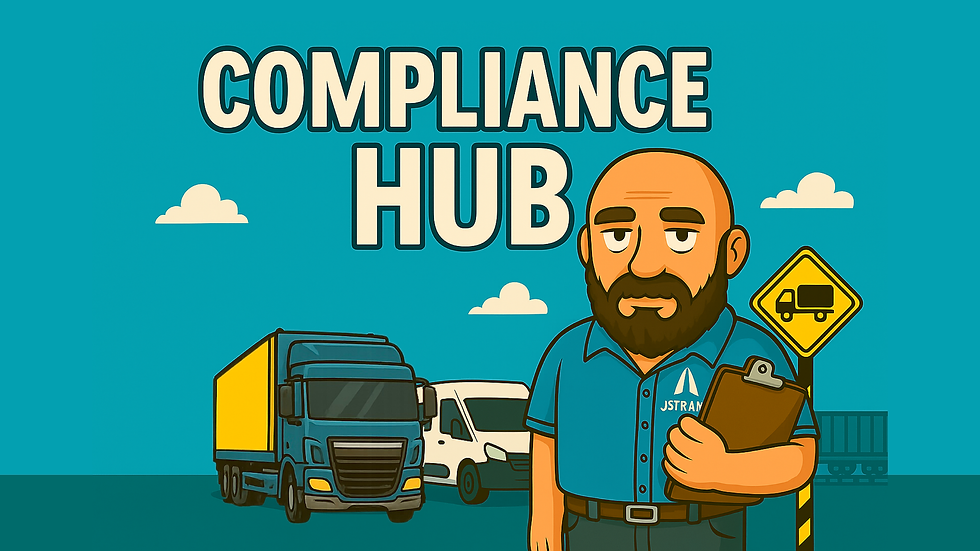Should You Upgrade to a Standard Licence? Pros & Cons for Small Businesses
- stuart47304
- Jul 14
- 3 min read

If you’re running a small fleet or operate under a Restricted Operator Licence, you may have wondered whether upgrading to a Standard Operator Licence is the right move for your business. This is a big decision — one that can have significant operational, financial, and compliance implications.
In this comprehensive guide, we’ll explore:
What distinguishes a Restricted Licence from a Standard Licence
The benefits of upgrading
The challenges and costs involved
Whether it’s the right choice for your business
Practical steps to upgrade if you decide to go ahead
By the end, you’ll have a clear understanding to make an informed, confident decision.
Understanding the Difference: Restricted vs Standard Licence
Restricted Operator Licence
Intended for operators who only carry goods for their own business
Typically for small fleets (often 1-5 vehicles)
No requirement for a qualified Transport Manager or compliance officer
Less complex application and ongoing compliance requirements
Cannot carry goods for hire or reward (i.e. you cannot transport goods for other businesses or individuals for payment)
Standard Operator Licence
Allows carriage of goods for hire or reward
Required for operators with larger fleets or those carrying third-party goods
Requires a qualified Transport Manager or professional compliance function
More extensive compliance, record-keeping, and regulatory oversight
Can operate nationally and internationally
Why Consider Upgrading to a Standard Licence?
1. Ability to Carry Goods for Hire or Reward
If your business model is evolving to include:
Contract haulage
Courier or delivery services for other companies
Subcontracting or third-party logistics
You must upgrade to a Standard Licence. Restricted Licence holders are legally prohibited from these activities.
2. Access to a Larger Market and More Customers
With a Standard Licence, you can bid for contracts and work that require hire or reward carriage. This opens up new revenue streams and business growth opportunities.
3. More Vehicles, More Flexibility
Standard Licences can authorise larger fleets, often starting at 5 vehicles and up, which suits growing businesses needing to expand capacity.
4. Improved Industry Credibility
Holding a Standard Licence, especially with a qualified Transport Manager, signals professionalism and compliance commitment to clients, insurers, and lenders.
5. Potential for Greater Operational Efficiency
With professional management and compliance systems typical in Standard Licence operations, you may achieve better route planning, fuel efficiency, and driver management.
What Are the Downsides or Challenges?
1. Increased Compliance Burden
Standard Licence holders must:
Employ or contract a qualified Transport Manager
Keep detailed records on maintenance, driver hours, tachographs, and finance
Meet stricter financial standing requirements
Undergo more frequent and thorough DVSA inspections
This adds administrative overhead and costs.
2. Higher Financial Standing Requirements
The minimum financial standing requirements are significantly higher:
Licence Type | First Vehicle | Additional Vehicles |
Restricted | £3,100 | £1,700 |
Standard | £8,000 | £4,500 |
This means you need more cash or assets to prove financial health.
3. Tachograph and Driver Hours Rules Apply Rigorously
Standard Licence holders must comply fully with tachograph regulations and drivers’ hours rules. This involves:
Fitting digital tachographs to vehicles over 3.5 tonnes
Downloading and analysing driver data regularly
Keeping records for 12 months
For operators used to exemption, this is a big change.
4. Cost of Employing a Transport Manager
Hiring a qualified TM adds payroll costs and management complexity. Alternatively, you can outsource the role to a consultant, but this too involves fees.
5. Potential Public Inquiry Risks
The Traffic Commissioner takes Standard Licence compliance very seriously. Any compliance lapses can lead to Public Inquiries, which are time-consuming and potentially business-threatening.
Is Upgrading Right for Your Business?
Consider these questions:
Question | What It Means |
Are you carrying goods for other businesses? | Legally must upgrade |
Do you plan to grow your fleet beyond 5 vehicles? | Standard Licence likely needed |
Can you afford the financial standing requirements? | Must be able to prove funds |
Are you ready for increased compliance responsibilities? | Need systems and TM |
Would new market opportunities significantly benefit you? | Weigh against extra costs |
Practical Steps to Upgrade
Review Your Current OperationDocument vehicles, drivers, financials, and intended business activities.
Plan Your Compliance SystemsPrepare to employ or outsource a Transport Manager, and establish maintenance, driver hours, and record-keeping systems.
Check Financial StandingEnsure you meet or can meet the higher financial thresholds.
Prepare Your ApplicationComplete the Standard Licence application via the Traffic Commissioners’ online portal.
Submit and Prepare for ScrutinyThe OTC will review your application, including your Transport Manager’s qualifications and your financial standing.
Respond to Any Enquiries or Public InquiryBe ready to explain and demonstrate compliance plans.
Final Thoughts
Upgrading to a Standard Operator Licence is a major step that offers growth opportunities but comes with heavier responsibilities and costs.
For some small businesses, a Restricted Licence remains the best fit. For others, the ability to carry goods for hire or reward and access larger markets justifies the additional compliance and financial burden.
Carefully assess your business model, finances, and readiness before deciding. When in doubt, seek expert advice.
